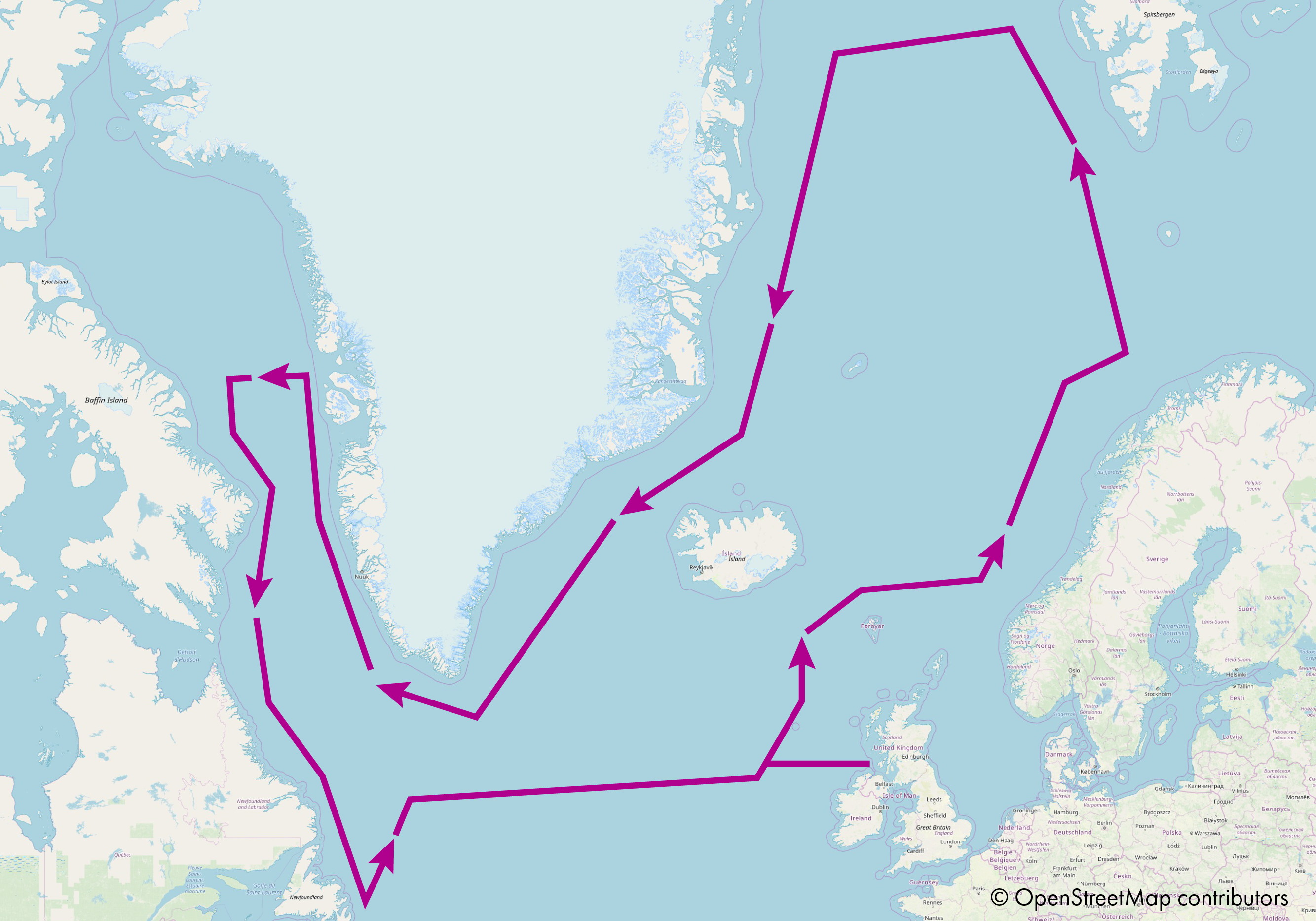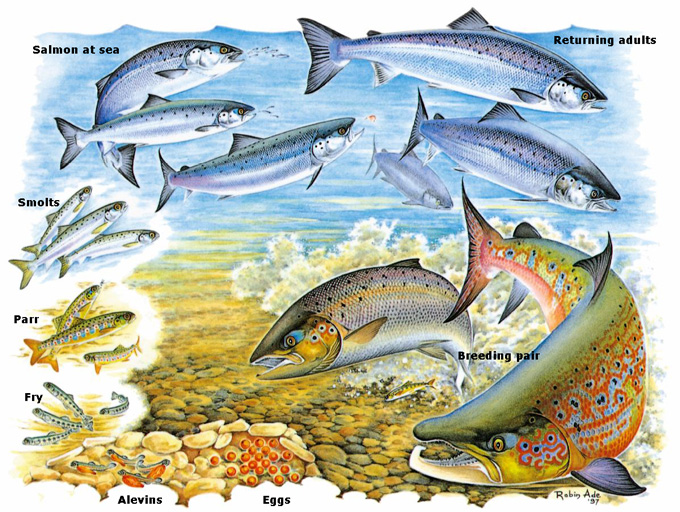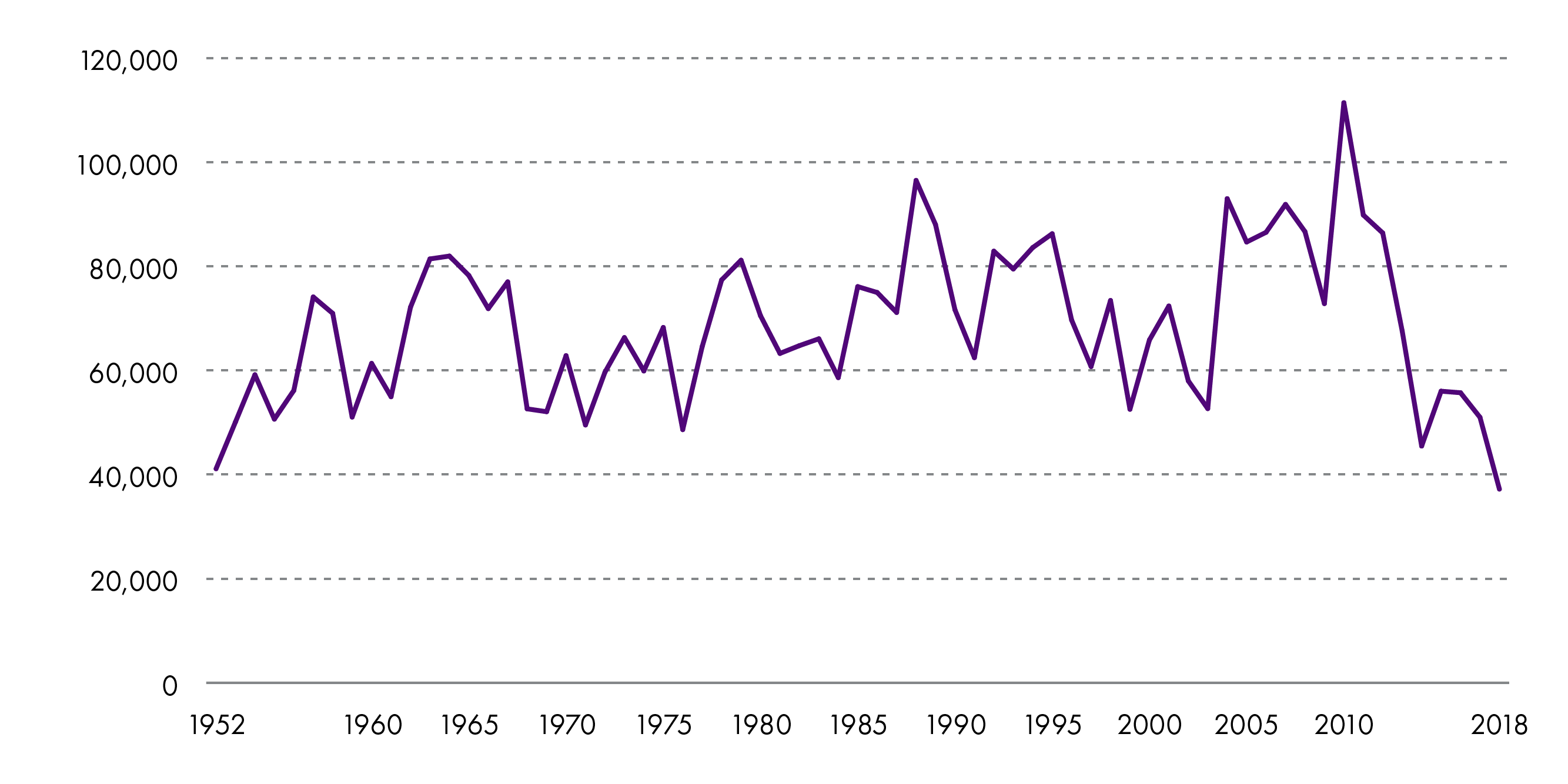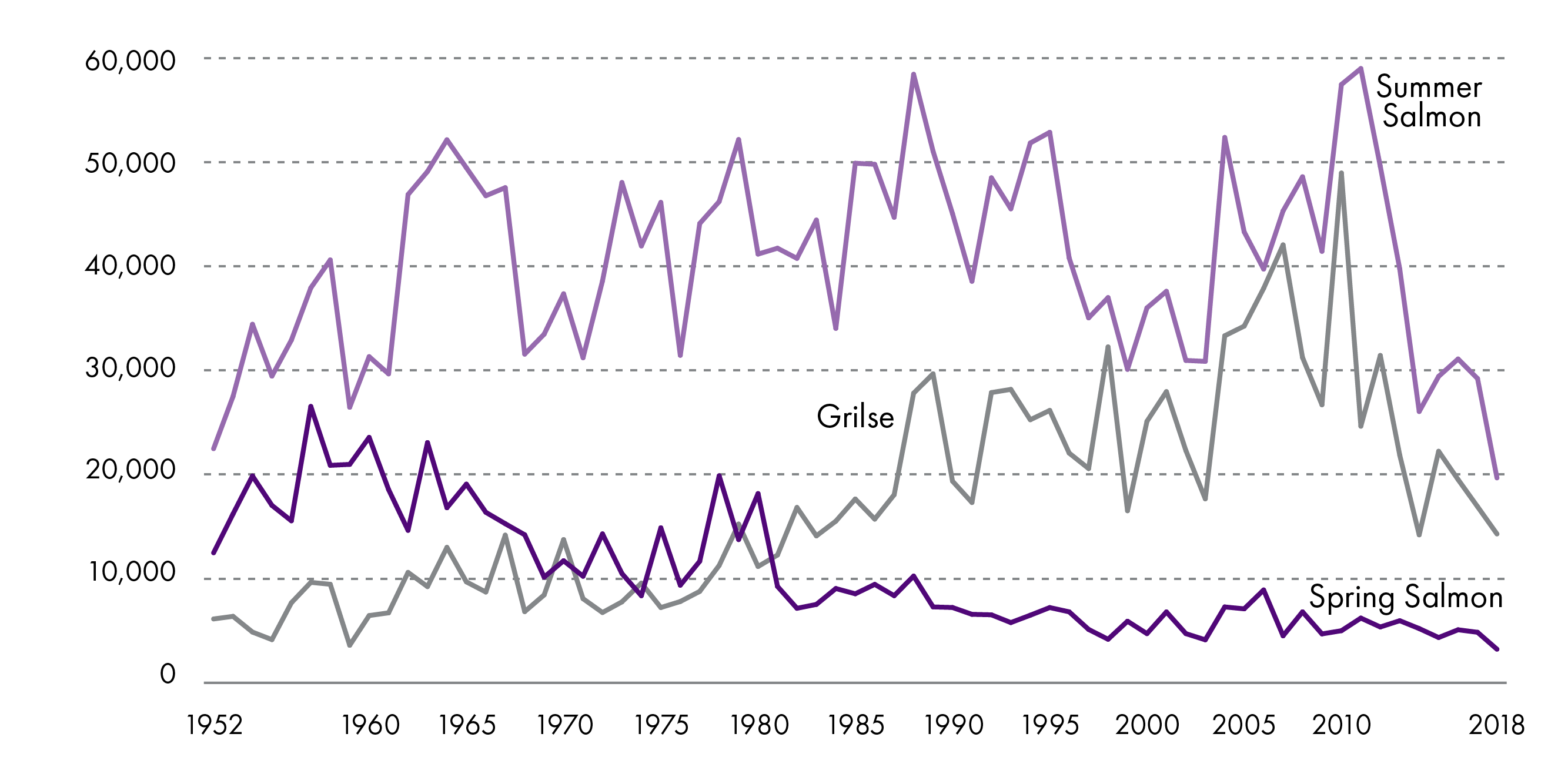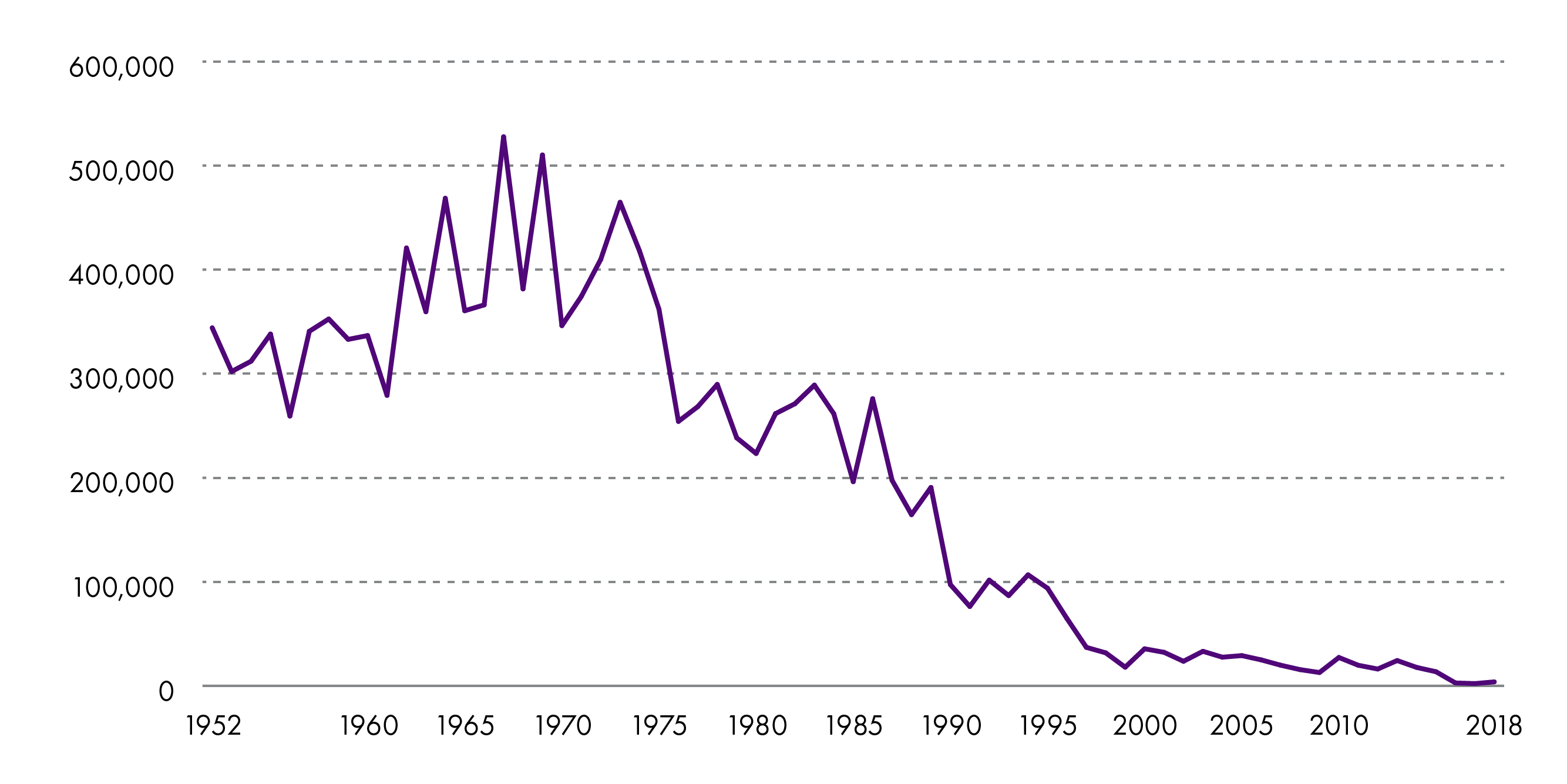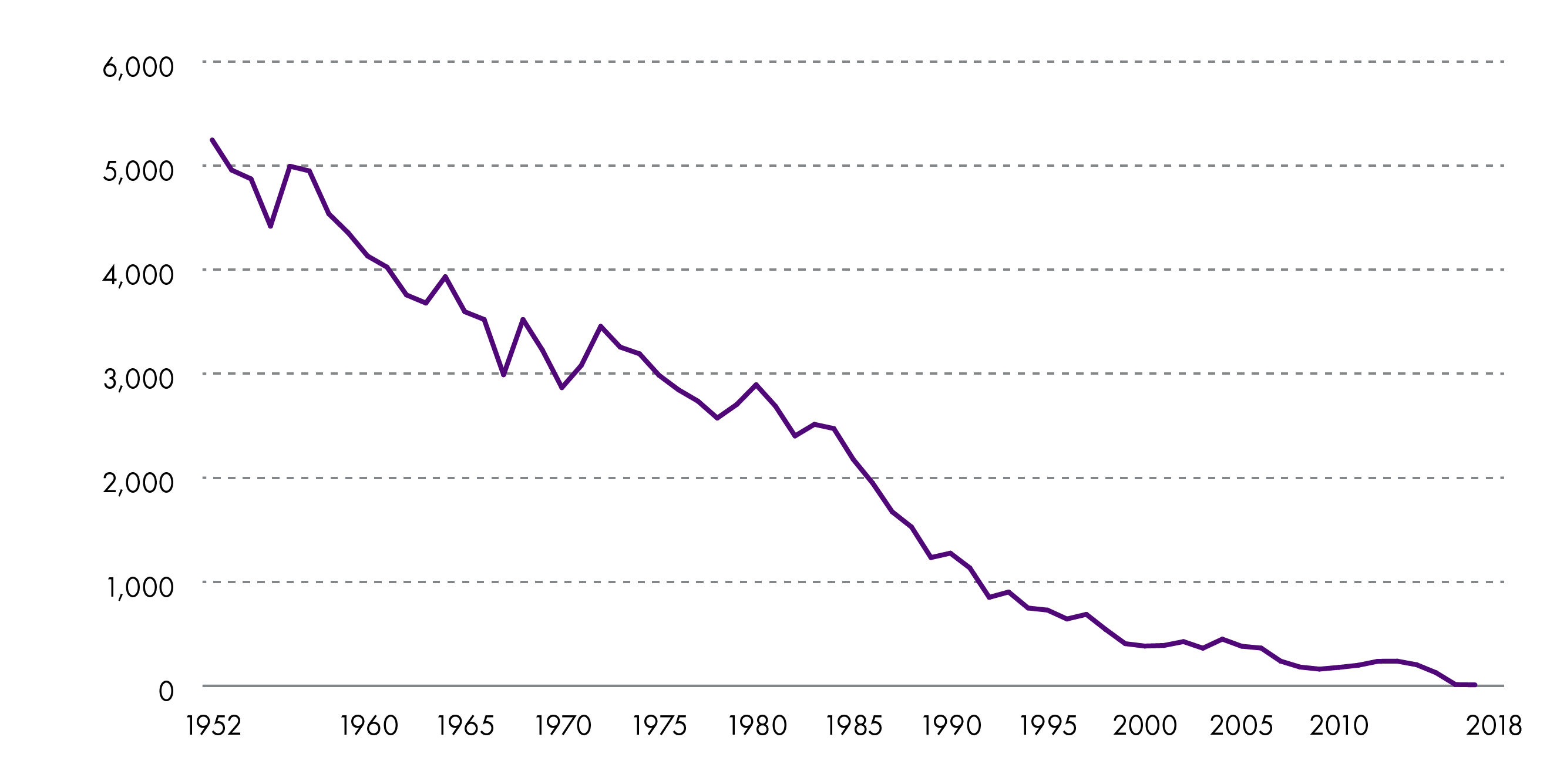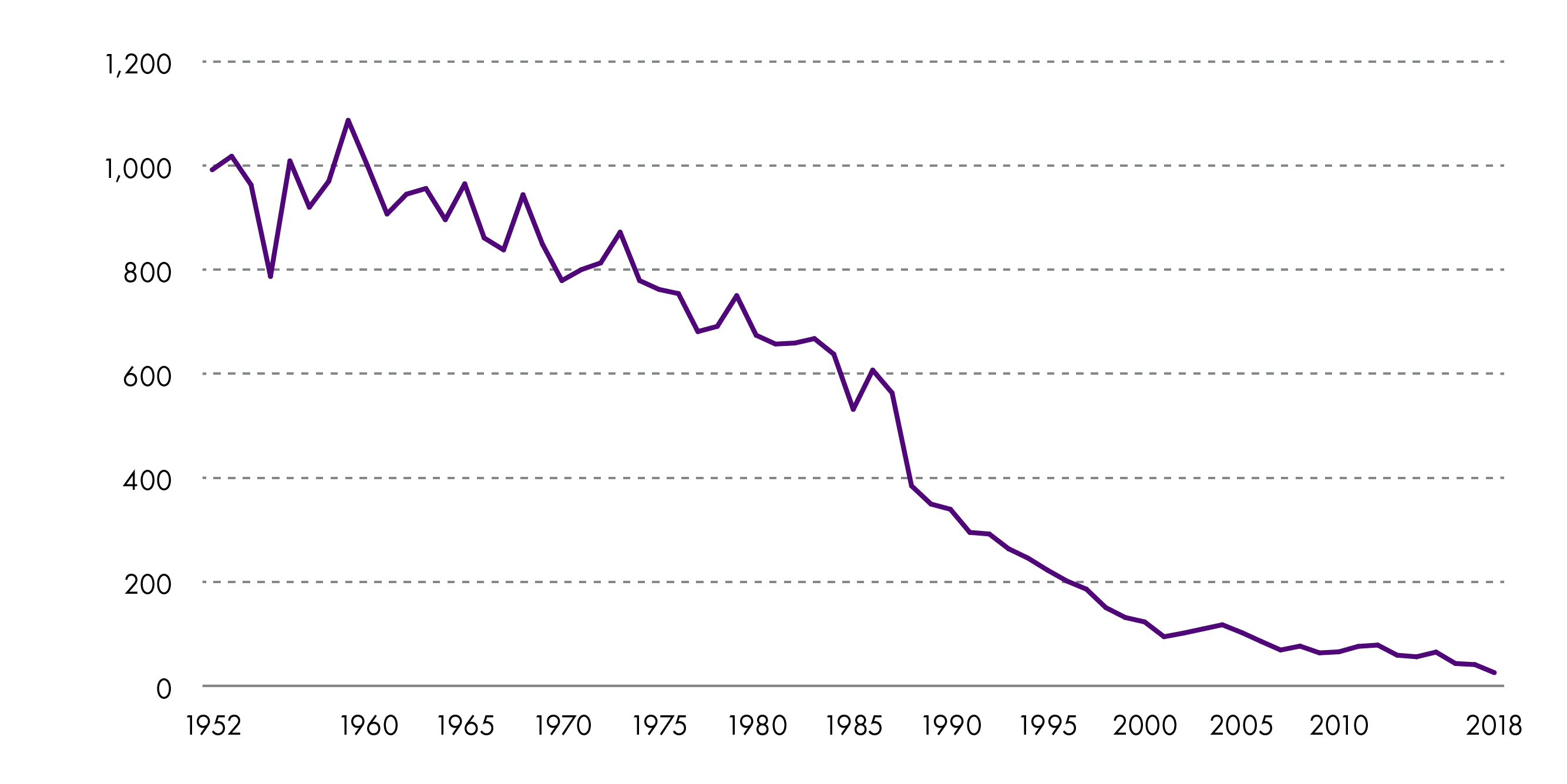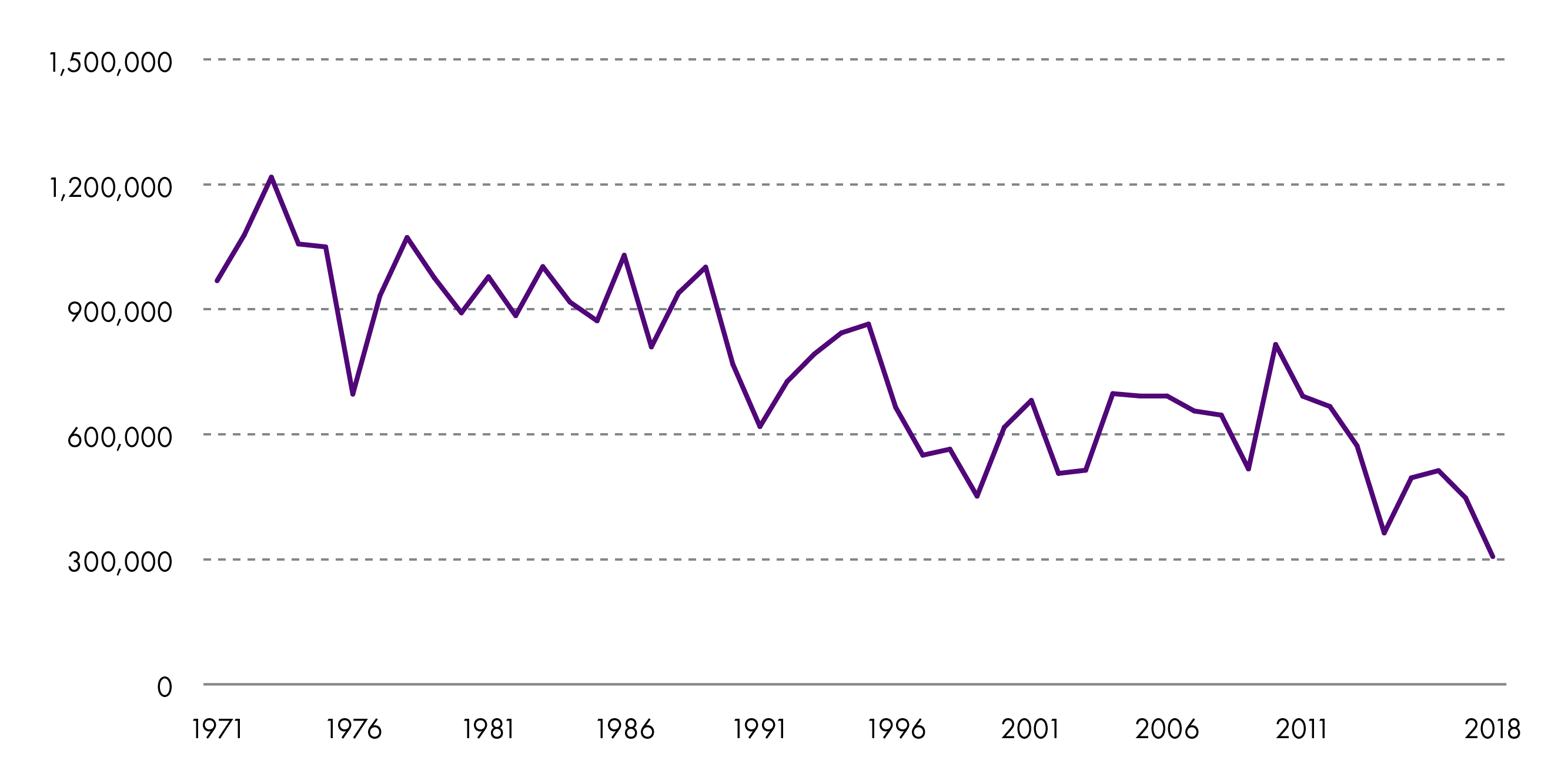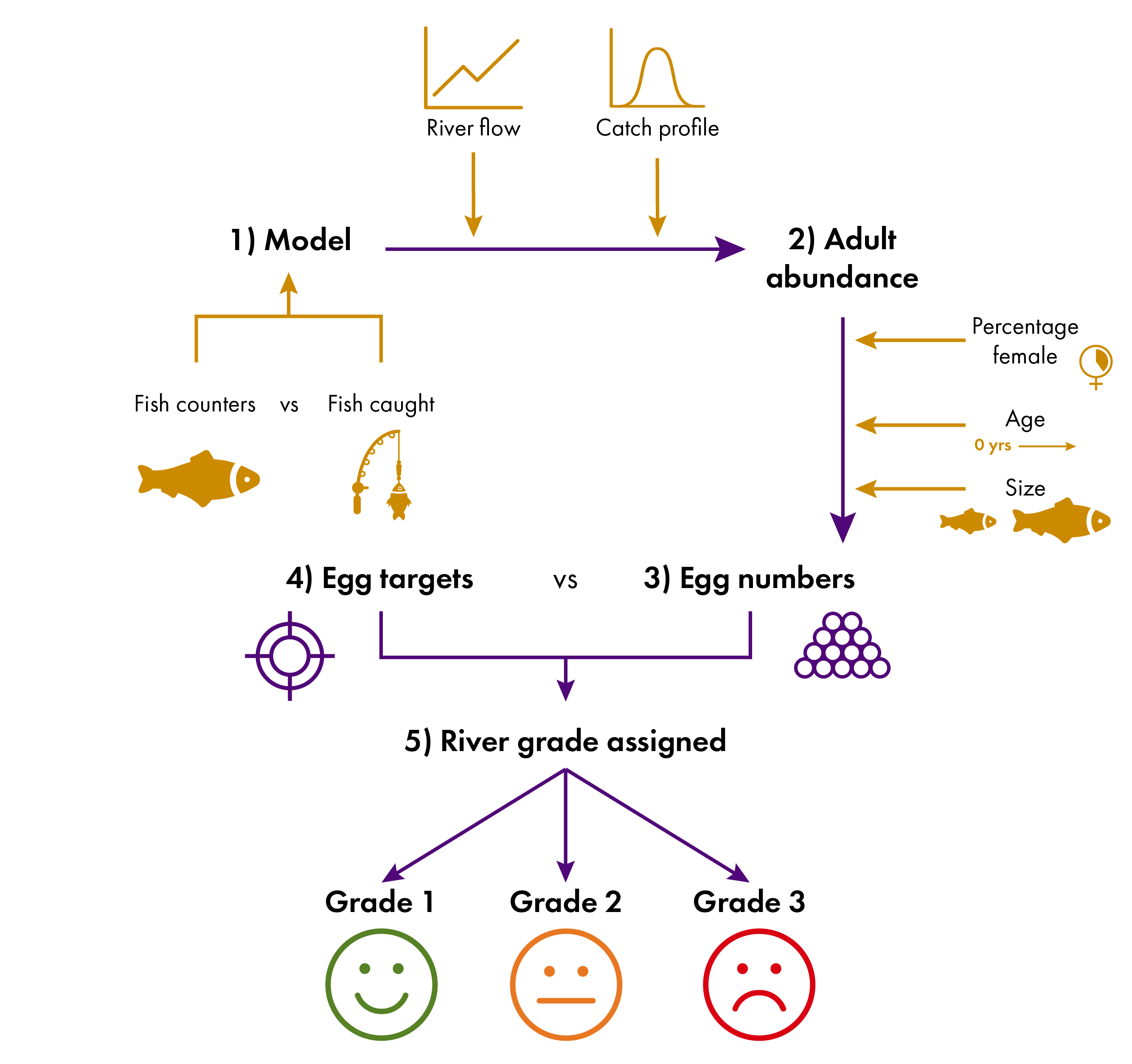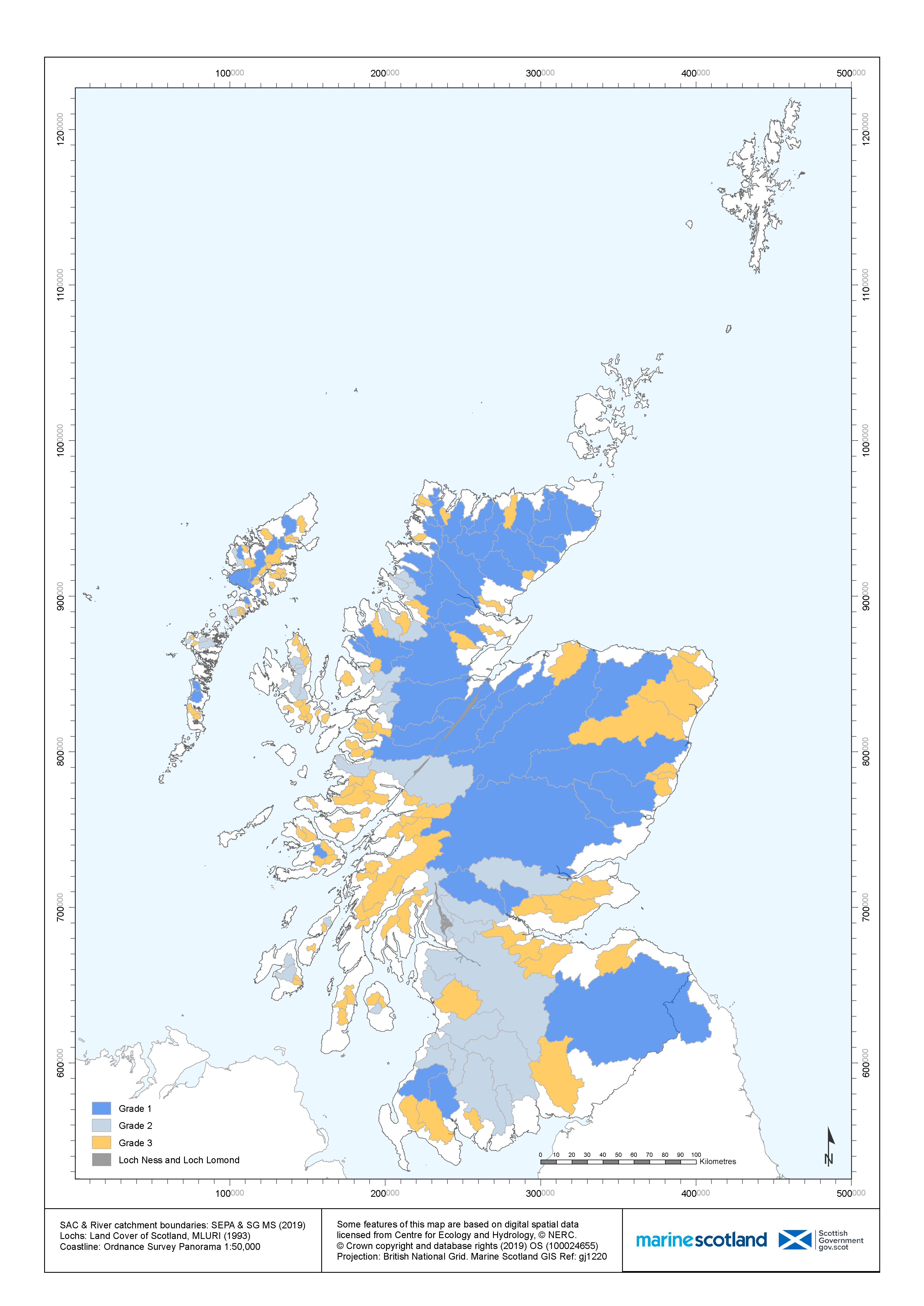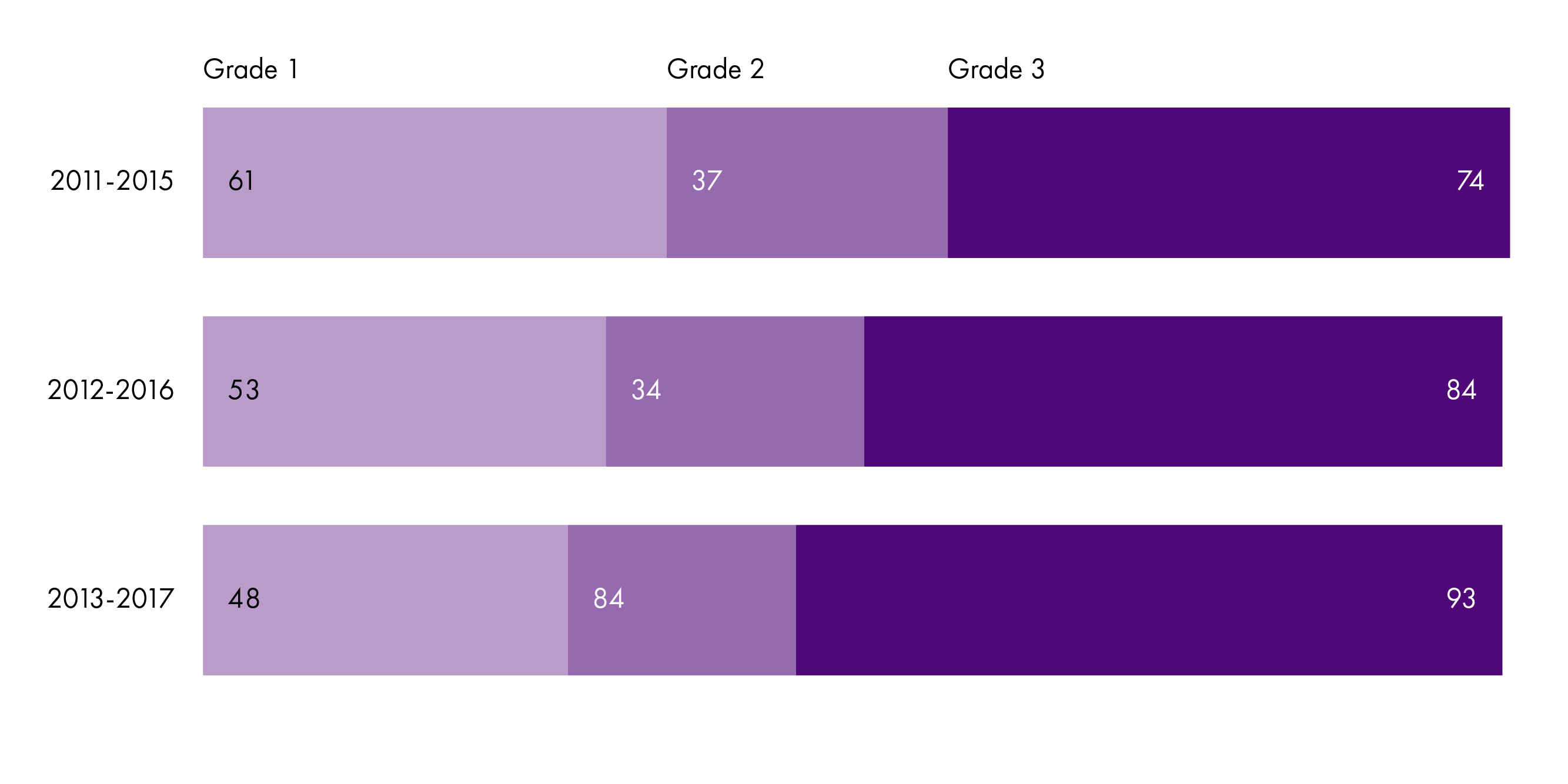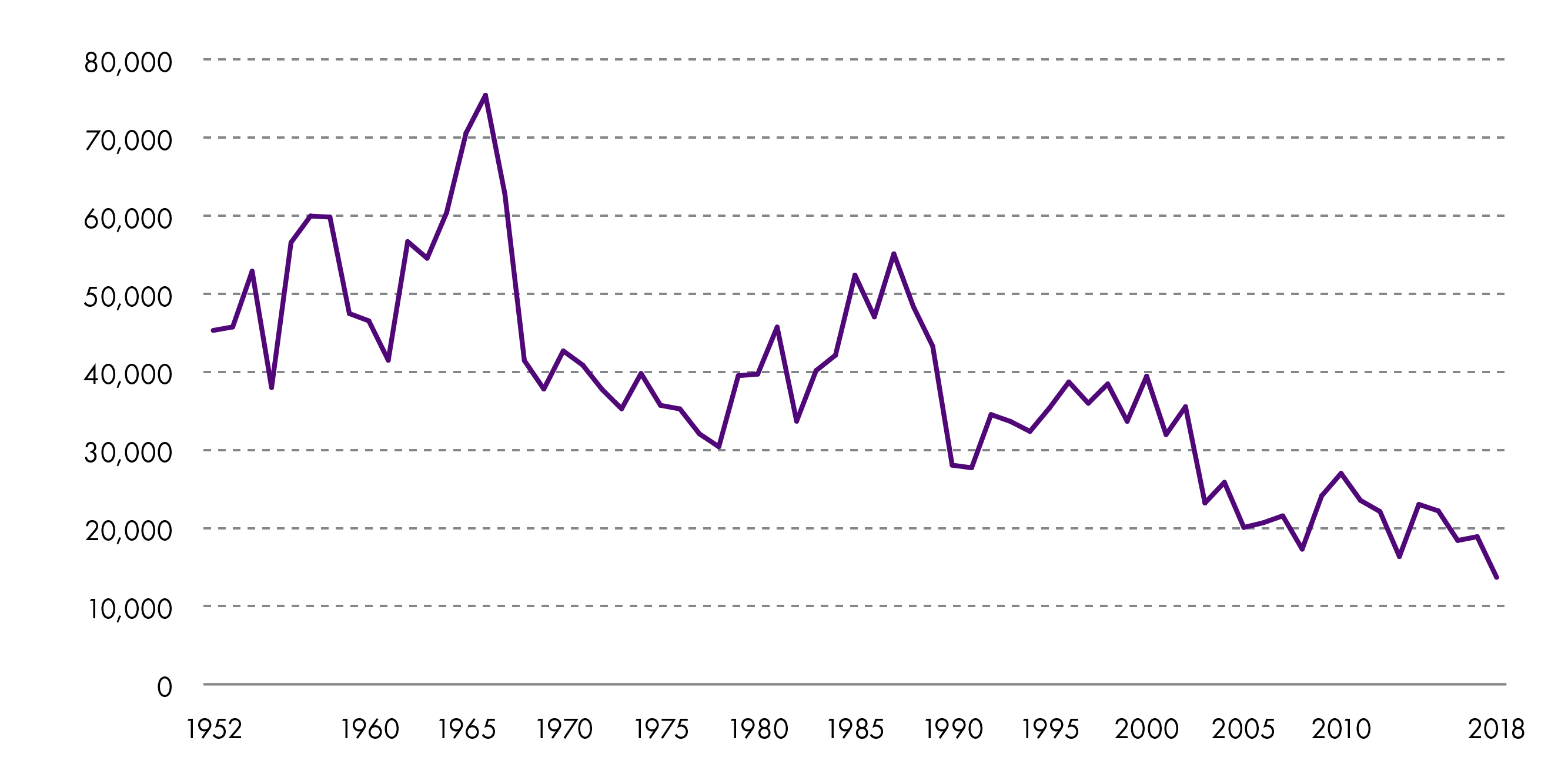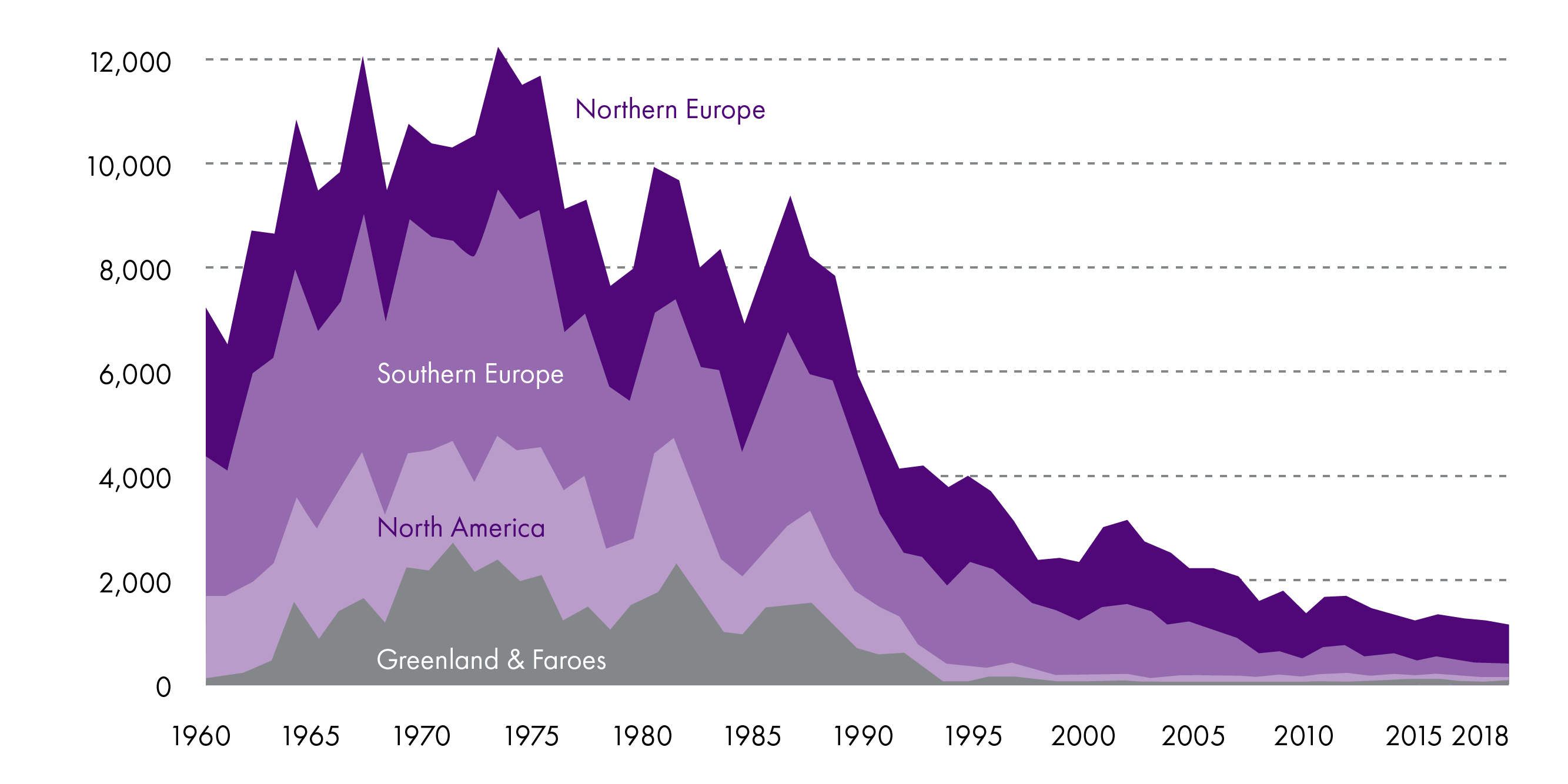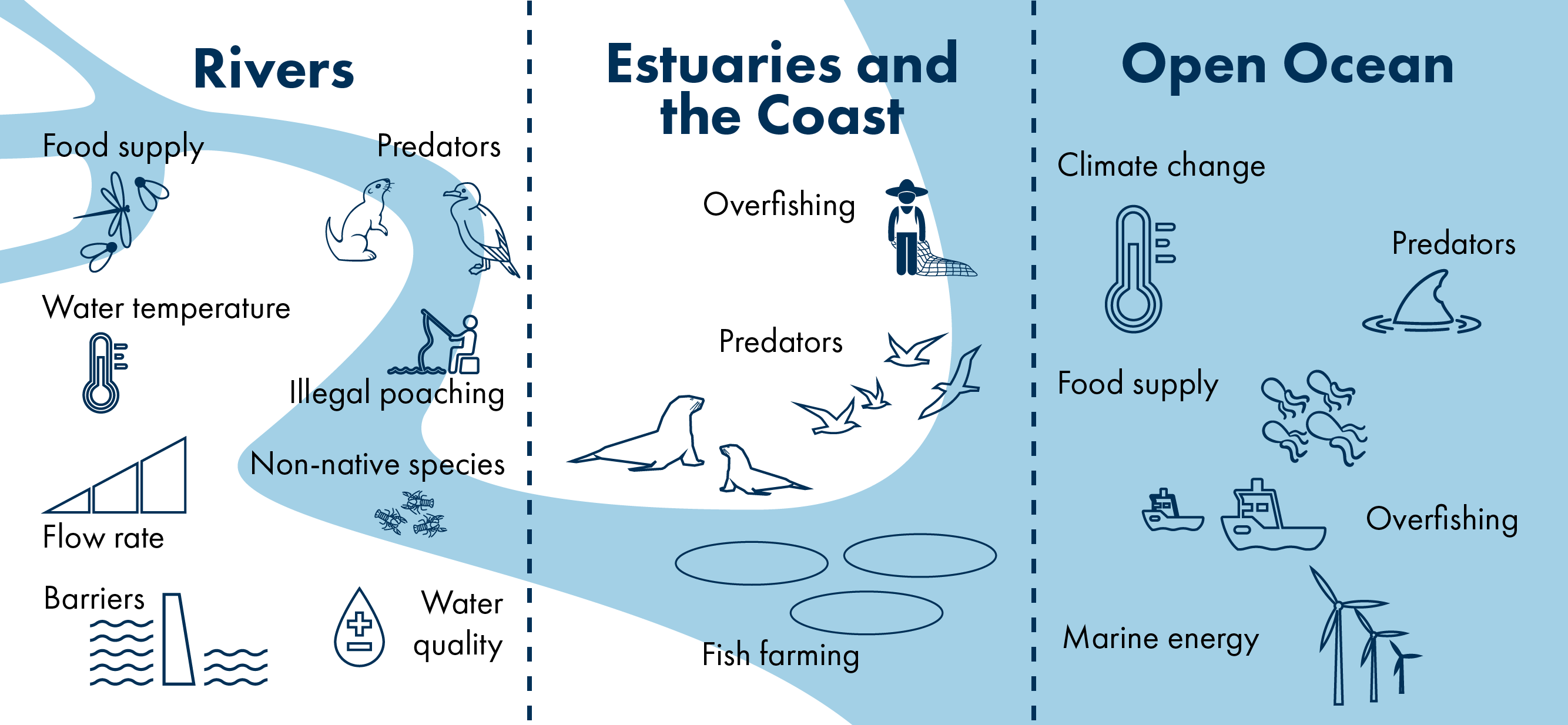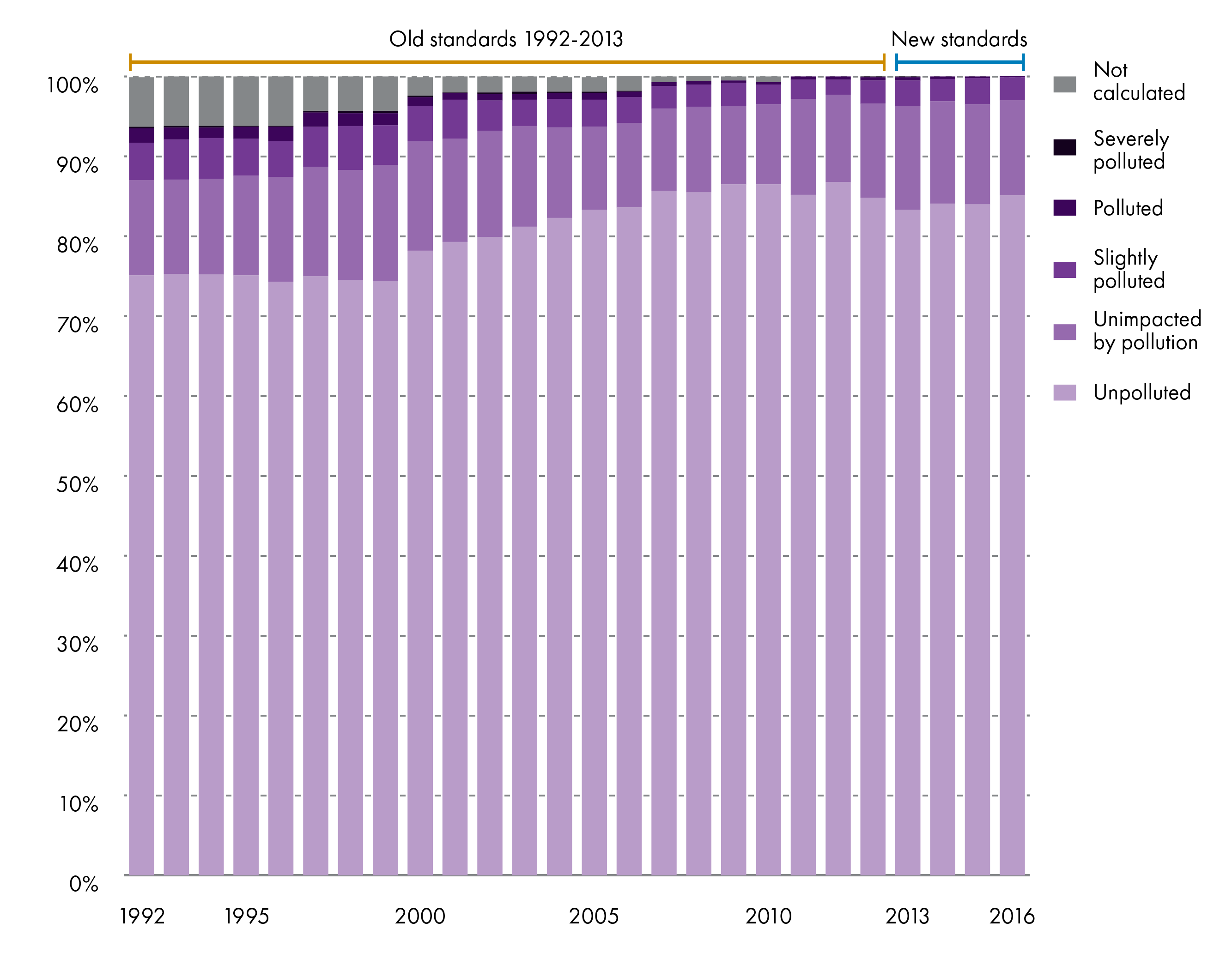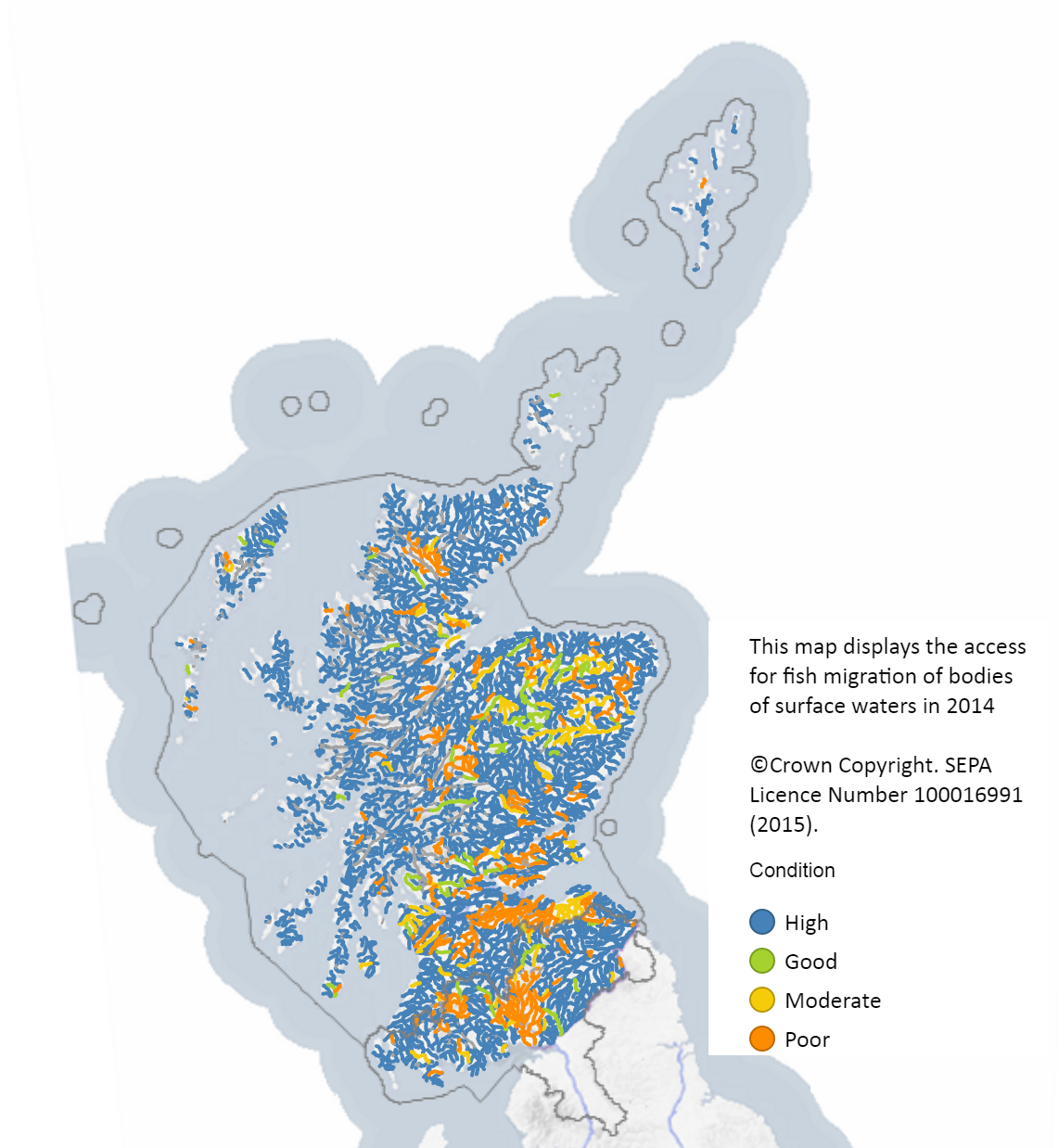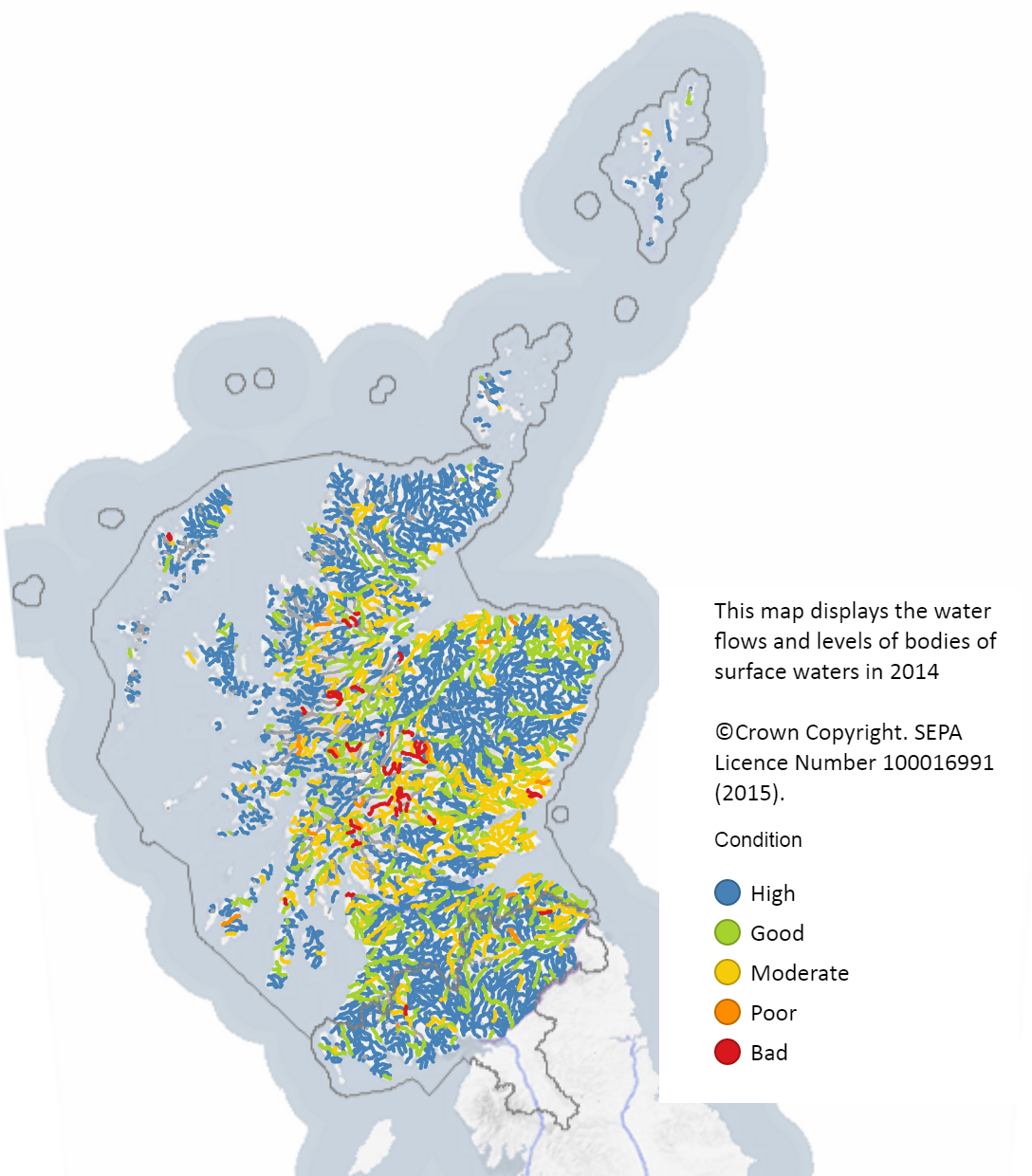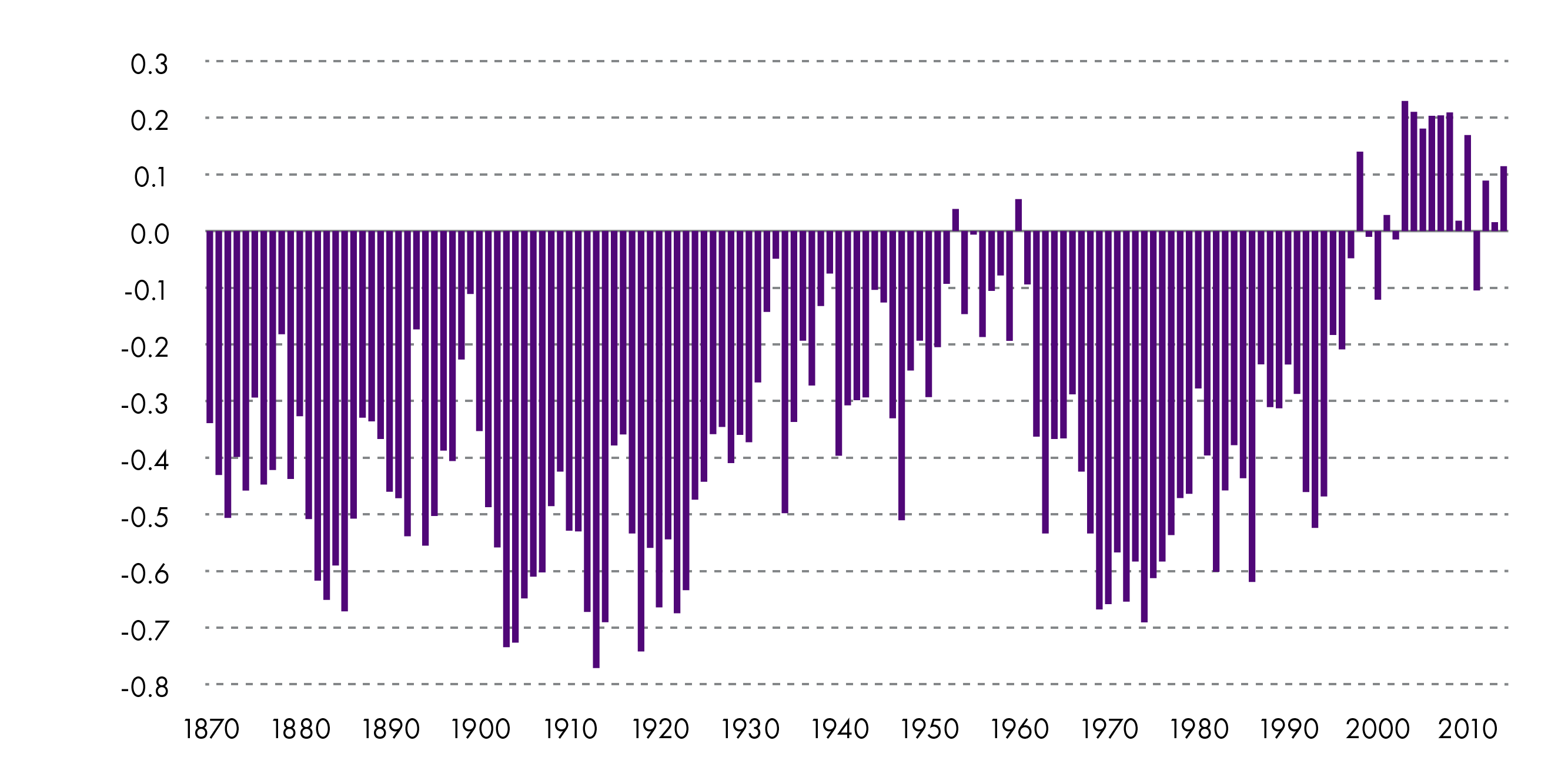Dadswell, M.J., Spares, A.D., Reader, J.M., & Stokesbury, M.J.W. (2010). The North Atlantic subpolar gyre and the marine migration of Atlantic salmon Salmo salar: the ‘Merry-Go-Round’ hypothesis. Journal of Fish Biology. doi: https://doi.org/10.1111/j.1095-8649.2010.02673.x
Hendry, K., & Cragg-Hine, D. (2003). Ecology of the Atlantic Salmon. (n.p.): English Nature.
Nelson, J.S., Schultze, H.P., & Wilson, M.V.H. (2010). Origin and Phylogenetic Interrelationships of Teleosts. München: Verlag Dr. Friedrich Pfeil.
Samways, K.M., Blair, T.J., Charest, M.A., & Cunjak, R.A. (2017). Effects of spawning Atlantic salmon (Salmo salar) on total lipid content and fatty acid composition of river food webs. Ecosphere, 8(6). doi: https://doi.org/10.1002/ecs2.1818
Harris, C.M., Calladine, J.R., Wernham, C.V., & Park, K.J. (2008). Impacts of piscivorous birds on salmonid populations and game fisheries in Scotland: a review. Wildlife Biology, 14, 395-411.
Joint Nature Conservation Committee. (2016, August 15). UK BAP priority terrestrial invertebrate species. Retrieved from
http://jncc.defra.gov.uk/page-5169 [accessed 9 May 2019]
Ziuganov, V.V., & Zotin, A.A. (1995). SYMBIOSIS OF FRESHWATER PEARL MUSSELS AND ATLANTIC SALMON. Twelfth International Malacological Congress, Vigo, Spain, 3rd-8th September 1995.
Winfield, I.J., Hateley, J., Fletcher, J.M., James, J.B., Bean, C.W., & Clabburn, P. (2010). Population trends of Arctic charr (Salvelinus alpinus) in the UK: assessing the evidence for a widespread decline in response to climate change. Hydrobiologia, 650, 55-65. doi: 10.1007/s10750-009-0078-1
Crozier, W.W., Schön, P.J., Chaput, G., Potter, E.C.E., Maoiléidigh, N., & MacLean, J.C. (2004). Managing Atlantic salmon (Salmo salar L.) in the mixed stock environment: challenges and considerations. ICES Journal of Marine Science, 61, 1344-1358. doi: 10.1016/j.icesjms.2004.08.013
Jonsson, N., Jonsson, B., & Hansen, L.P. (1998). The relative role of density-dependent and density-independent survival in the life cycle of Atlantic salmon Salmo salar. Journal of Animal Ecology, 67, 640-762.
Nicieza, A.G., & Metcalfe, M.B. (1997). Growth Compensation in Juvenile Atlantic Salmon: Responses to Depressed Temperature and Food Availability. Ecology, 78(8), 2385-2400.
Elliot, J.M., & Elliot, J.E. (2010). Temperature requirements of Atlantic salmon Salmo salar, brown trout Salmo trutta and Arctic charr Salvelinus alpinus: predicting the effects of climate change. Journal of Fish Biology, 77, 1793-1817. doi: 10.1111/j.1095-8649.2010.02762.x
Cappell, R., Tetzlaff, D., & Soulsby, C. (2013). Will catchment characteristics moderate the projected effects of climate change on flow regimes in the Scottish Highlands?. Hydrological Processes, 27, 687-699. doi: 10.1002/hyp.9626
Dugdale, S.J., Malcolm, I.A., Kantola, K., & Hannah, D.M. (2018). Stream temperature under contrasting riparian forest cover: Understanding thermal dynamics and heat exchange processes. Science of the Total Environment, 1375-1389. doi: http://dx.doi.org/10.1016/j.scitotenv.2017.08.198
Garner, G., Malcolm, I.A., Sadler, J.P., & Hannah, D.M. (2017). The role of riparian vegetation density, channel orientation and water velocity in determining river temperature dynamics. Journal of Hydrology, 553, 471-485. doi: http://dx.doi.org/10.1016/j.jhydrol.2017.03.024
Kawaguchi, Y., & Nakano, S. (2001). Contribution of terrestrial invertebrates to the annual resource budget for salmonids in forest and grassland reaches of a headwater stream. Freshwater Biology, 46, 303-316.
Hendry, K., Cragg-Hine, D., O’Grady, M., Sambrook, H., & Stephen, A. (2003). Management of habitat for rehabilitation and enhancement of salmonid stocks. Fisheries Research, 62, 171-192.
Seavy, N.E., Gardali, T., Golet, G.H., Griggs, T., Howell, C.A., Kelsey, R., … Weigand, J.F. (2009). Why Climate Change Makes Riparian Restoration More Important than Ever: Recommendations for Practice and Research. Ecological Restoration, 27(3), 330-338.
Addy, S., Cooksley, S., Dodd, N., Waylen, K., Stockan, J., Byg, A., … Holstead, K. (2016). River Restoration and Biodiversity. Retrieved from
http://www.ecrr.org/Portals/27/River%20Restoration%20and%20biodiversity_web_1.pdf [accessed 21 June 2019]
Kroglund, F., Rosseland, B.O., Teien, H.C., Salbu, B., Kristensen, T., & Finstad, B. (2008). Water quality limits for Atlantic salmon (Salmo salar L.) exposed to short term reductions in pH and increased aluminum simulating episodes. Hydrology and Earth System Sciences, 12, 491-507.
Neal, C., Rowland, P., Neal, M., Jarvie, H.P., Lawlor, A., Sleep, D., … Scholefield, P. (2011). Aluminium in UK rivers: a need for integrated research related to kinetic factors, colloidal transport, carbon and habitat. Journal of Environmental Monitoring, 13, 2153-2164.
Solbe, J. (1997). Water Quality for Salmon and Trout. Pitlochry: The Atlantic Salmon Trust.
Malcolm, I.A., Youngson, A.F., & Soulsby, C. (2003). SURVIVAL OF SALMONID EGGS IN A DEGRADED GRAVEL-BED STREAM: EFFECTS OF GROUNDWATER–SURFACE WATER INTERACTIONS. River Research and Applications, 19, 303-316.
Armstrong, J.D., Kemp, P.S., Kennedy, G.J.A., Ladle, M., & Milner, N.J. (2003). Habitat requirements of Atlantic salmon and brown trout in rivers and streams. Fisheries Research, 62, 143-170.
Malcolm, I.A., Soulsby, C., Youngson, A.F., Hannah, D.M., McLaren, I.S., & Thorne, A. (2004). Hydrological Processes. Hydrological influences on hyporheic water quality: implications for salmon egg survival, 18, 1543-1560.
Bilotta, G.S., & Brazier, R.E. (2008). Understanding the influence of suspended solids on water quality and aquatic biota. Water Research, 42, 2849-2861.
Knoph, M.B. (1992). ACUTE TOXICITY OF AMMONIA TO ATLANTIC SALMON (SALMO SALAR) PARR. Comparative Biochemistry and Physiology - Part C: Comparative Pharmacology and Toxicology, 101, 275-282.
Williams, E.M., & Eddy, F.B. (1989). Effect of Nitrite on the Embryonic Development of Atlantic Salmon (Salmo salar). Canadian Journal of Fisheries and Aquatic Sciences, 46(10), 1726-1729.
Moore, A., & Waring, C.P. (2001). The effects of a synthetic pyrethroid pesticide on some aspects of reproduction in Atlantic salmon (Salmo salar L.).. Aquatic Toxicology, 52, 1-12.
Moore, A., & Lower, N. (2001). The impact of two pesticides on olfactory-mediated endocrine function in mature male Atlantic salmon ž Salmo salar L./ parr. Comparative Biochemistry and Physiology Part B, 129, 269-276.
Waring, C.P., & Moore, A. (1997). Sublethal effects of a carbamate pesticide on pheromonal mediated endocrine function in mature male Atlantic salmon (Salmo salar L.) parr. Fish Physiology and Biochemistry, 17, 203-211.
Moore, A., & Waring, C.P. (1996). Sublethal effects of the pesticide Diazinon on olfactory function in mature male Atlantic salmon parr. Journal of Fish Biology, 48(4), 758-775.
Kjelland, M.E., Woodley, C.M., Swannack, T.M., & Smith, D.L. (2015). A review of the potential effects of suspended sediment on fishes: potential dredging-related physiological, behavioral, and transgenerational implications. Environment Systems and Decisions, 35, 334-350.
Robertson, M.J., Scruton, D.A., & Clarke, K.D. (2007). Seasonal Effects of Suspended Sediment on the Behavior of Juvenile Atlantic Salmon. Transactions of the American Fisheries Society, 136, 822-828.
Humphreys, E.M., Gillings, S., Musgrove, A., Austin, G., Marchant, J., & Calladine, J. (2016). An update of the review on the impacts of piscivorous birds on salmonid populations and game fisheries in Scotland. Retrieved from
https://www.nature.scot/sites/default/files/Publication%202016%20-%20SNH%20Commissioned%20Report%20884%20-%20An%20update%20of%20the%20review%20on%20the%20impacts%20of%20piscivorous%20birds%20on%20salmonid%20populations%20and%20game%20fisheries%20in%20Scotland.pdf [accessed 29 May 2019]
Lothian, A.J., Newton, M., Barry, J., Walters, M., Millar, R.C., & Adams, C.E. (2017). Migration pathways, speed and mortality of Atlantic salmon (Salmo salar) smolts in a Scottish river and the near-shore coastal marine environment. Ecology of Freshwater Fish, 27(2), 549-558.
Carss, D.N., Kruuk, H., & Conroy, J.W.H. (1990). Predation on adult Atlantic salmon, Salmo salar L., by otters, Lutra lutra (L.), within the River Dee system, Aberdeenshire, Scotland. Jourtial of Fish Biology,, 37, 935-944.
Heggenes, J., & Borgstrøm, R. (1988). Effect of mink, Mustela vison Schreber, predation on cohorts of juvenile Atlantic salmon, Salmo salar L., and brown trout, S. trutta L., in three small streams. Journal of Fish Biology. doi: https://doi.org/10.1111/j.1095-8649.1988.tb05536.x
Carter, T.J., Pierce, G.J., Hislop, J.R.G., Houseman, J.A., & Boyle, P.R. (2001). Predation by seals on salmonids in two Scottish estuaries. Fisheries Management and Ecology, 8, 207-225.
Matejusová, I., Doig, F., Middlemas, S.J., Mackay, S., Douglas, A., Armstrong, J.D., … Snow, M. (2008). Using quantitative real-time PCR to detect salmonid prey in scats of grey Halichoerus grypus and harbour Phoca vitulina seals in Scotland – an experimental and field study. Journal of Applied Ecology, 45, 632-640. doi: 10.1111/j.1365-2664.2007.01429.x
Bulter, J.R.A., Middlemas, S.J., Graham, I.M., Thompson, P.M., & Armstrong, J.D. (2006). Modelling the impacts of removing seal predation from Atlantic salmon, Salmo salar, rivers in Scotland: a tool for targeting conflict resolution. Fisheries Management and Ecology, 13, 285-291.
Chamberlain, D.E., Austin, G.E., Newson, S.E., Johnston, A., & Burton, N.H.K. (2013). Licensed control does not reduce local Cormorant Phalacrocorax carbo population size in winter. Journal of Ornithology, 154(3), 739-750.
Bryce, R., Oliver, M.K., Davies, L., Gray, H., Urquhart, J., & Lambin, X. (2011). Turning back the tide of American mink invasion at an unprecedented scalethrough community participation and adaptive management. Biological Conservation, 144, 575-583.
Graham, I.M., Harris, R.N., Denny, B., Fowden, D., & Pullan, D. (2009). Testing the effectiveness of an acoustic deterrent device for excluding seals from Atlantic salmon rivers in Scotland. ICES Journal of Marine Science, 66(5), 860-864. doi: https://doi.org/10.1093/icesjms/fsp111
Behavioural responses of seals to pulsed, low-voltage electric fields in sea water (preliminary tests). (n.d.)
Thorstad, E.B., Økland, F., Aarestrup, K., & Heggberget, T.G. (2008). Factors affecting the within-river spawning migration of Atlantic salmon, with emphasis on human impacts. Reviews in Fish Biology and Fisheries, 18(4), 345-371.
Gowans, A.R.D., Armstrong, J.D., Priede, I.G., & Mckelvey, S. (2003). Movements of Atlantic salmon migrating upstream through a fish-pass complex in Scotland. Ecology of Freshwater Fish, 12, 177-189.
Marschall, E.A., Mather, M.E., Parrish, D.L., Allison, G.W., & McMenemy, J.R. (2011). Migration delays caused by anthropogenic barriers: modeling dams, temperature, and success of migrating salmon smolts. Ecological Application, 21(8), 3014-3031.
Collen, P., & Gibson, R.J. (2001). The general ecology of beavers (Castor spp.), as related to their influence on stream ecosystems and riparian habitats, and the subsequent effects on fish – a review. Reviews in Fish Biology and Fisheries, 10, 439-461.
Warren, M., Dunbar, M.J., & Smith, C. (2015). River flow as a determinant of salmonid distribution and abundance: a review. Environmental Biology of Fishes, 98, 1695-1717. doi: 10.1007/s10641-015-0376-6
Milner, N.J., Solomon, D.J., & Smith, G.W. (2012). The role of river flow in the migration of adult Atlantic salmon, Salmo salar, through estuaries and rivers. Fisheries Management and Ecology, 19, 537-547.
Watts, G., Jenkins, A., Hess, T., Humble, A., Olbert, C., Kay, M., … Noble, A. (2015). Agriculture’s impacts on water availability. Retrieved from
https://www.foodsecurity.ac.uk/publications/agricultures-impacts-water-availability.pdf [accessed 04 June 2019]
Werritty, A. (2002). Living with uncertainty: climate change, river flows and water resource management in Scotland. The Science of the Total Environment, 294, 29-40.
Gosling, R. (2014). Assessing the impact of projected climate change on drought vulnerability in Scotland. Hydrology Research, 45(6), 806-816. doi: https://doi.org/10.2166/nh.2014.148
Orlov, A.V., Gerasimov, Y.V., & Lapshin, O.M. (2006). The feeding behaviour of cultured and wild Atlantic salmon, Salmo salar L., in the Louvenga River, Kola Peninsula, Russia. ICES Journal of Marine Science, 63, 1297-1303. doi: 10.1016/j.icesjms.2006.05.004
McLennan, D., Auer, S.K., Anderson, G.J., Reid, T.C., Basser, R.D., Stewart, D.C., … Metcalfe, N.B. (2019). Simulating nutrient release from parental carcasses increases the growth, biomass and genetic diversity of juvenile Atlantic salmon. Journal of Applied Ecology. doi: 10.1111/1365-2664.13429
Manchester, S.J., & Bullock, J.M. (2000). The impacts of non-native species on UK biodiversity and the effectiveness of control. Journal of Applied Ecology, 37, 845-864.
Armstrong, J.D., Bean, C.W., & Wells, A. (2018). The Scottish invasion of pink salmon in 2017. Journal of Fish Biology, 93, 8-11. doi: 10.1111/jfb.13680
Winfield, I.J., Fletcher, J.M., & James, J.B. (2011). Invasive fish species in the largest lakes of Scotland, Northern Ireland, Wales and England: the collective UK experience. Hydrobiologia, 660(1), 93-103.
Hedger, R.D., Uglem, I., Thorstad, E.B., Finstad, B., Chittenden, C.M., Arechavala-Lopez, ., … Økland, F. (2011). Behaviour of Atlantic cod, a marine fish predator, during Atlantic salmon post-smolt migration. ICES Journal of Marine Science, 68(10), 2152-2162. doi: 10.1093/icesjms/fsr143
North Atlantic Salmon Conservation Organisation. (2016). Addressing impacts of salmon farming on wild Atlantic salmon: Challenges to, and developments supporting, achievement of NASCO's international goals. Edinburgh: NASCO.
Taranger, G.L., Karlsen, ., Bannister, R.J., Glover, K.A., Husa, V., Karlsbakk, E., … Svåsand, T. (2014). Risk assessment of the environmental impact of Norwegian Atlantic salmon farming. ICES Journal of Marine Science. doi: 10.1093/icesjms/fsu132
Handeland, S.O., Järvi, T., Fernö, A., & Stefansson, S.O. (1996). Osmotic stress, antipredator behaviour, and mortality of Atlantic salmon (Salmo salar) smolts. Canadian Journal of Fisheries and Aquatic Sciences, 53(12), 2673-2680. doi: https://doi.org/10.1139/f96-227
Graham, I.M., Harris, R.N., Matejusova, I., & Middlemas, S.J. (2011). Do ‘rogue’ seals exist? Implications for seal conservation in the UK. Animal Conservation, 14, 587-598. doi: 10.1111/j.1469-1795.2011.00469.x
Hvidsten, N.A., & Møkkelgjerd, P.I. (1987). Predation on salmon smolts, Salmo salar L., in the estuary of the River Surna, Norway. Journal of Fish Biology. doi: https://doi.org/10.1111/j.1095-8649.1987.tb05752.x
Dieperink, C., Bak, B.D., Pedersen, L.F., Pedersen, M.I., & Pedersen, S. (2002). Predation on Atlantic salmon and sea trout during their first days as postsmolts. Journal of Fish Biology, 61, 858-852. doi: doi:10.1006/jfbi.2002.2090
Renkawitz, M.D., Sheehan, T.F., & Goulette, G.S. (2012). Swimming Depth, Behavior, and Survival of Atlantic Salmon Postsmolts in Penobscot Bay, Maine. Transactions of the American Fisheries Society, 141(5). doi: 10.1080/00028487.2012.688916
Mills, D. (2003). Salmon at the Edge. (n.p.): Wiley-Blackwell.
Chaput, G. (2012). Overview of the status of Atlantic salmon (Salmo salar) in the North Atlantic and trends in marine mortality. ICES Journal of Marine Science, 69(9), 1538-1548. doi: 10.1093/icesjms/fss013
Friedland, K.D., Chaput, G., & MacLean, J.C. (2005). The emerging role of climate in post-smolt growth of Atlantic salmon. ICES Journal of Marine Science, 62, 1338-1349. doi: 10.1016/j.icesjms.2005.04.013
Jonsson, N., & Jonsson, B. (2004). Size and age of maturity of Atlantic salmon correlate with the North Atlantic Oscillation Index (NAOI). Journal of Fish Biology, 64, 241-247. doi: 10.1046/j.1095-8649.2004.00269.x
Condron, A., DeConto, R., Bradley, R.S., & Juanes, F. (2005). Multidecadal North Atlantic climate variability and its effect on North American salmon abundance. Geophysical Research Letters, 32. doi: 10.1029/2005GL024239
Beaugrand, G., & Reid, P.C. (2012). Relationships between North Atlantic salmon, plankton, and hydroclimatic change in the Northeast Atlantic. ICES Journal of Marine Science, 69(9), 1549-1562. doi: 10.1093/icesjms/fss153
Nye, J.A., Link, J.S., Hare, J.A., & Overholtz, W.J. (2009). Changing spatial distribution of fish stocks in relation to climate and population size on the Northeast United States continental shelf. Marine Ecology Progress Series, 393, 111-129. doi: 10.3354/meps08220
IPCC. (2013). Climate Change 2013: The Physical Science Basis. Contribution of Working Group I to the Fifth Assessment Report of the Intergovernmental Panel on Climate Change. Cambridge: Cambridge University Press.
Haugland, M., Holst, J.C., Holm, M., & Hansen, L.P. (2006). Feeding of Atlantic salmon (Salmo salar L.) post-smolts in the Northeast Atlantic. ICES Journal of Marine Science, 63, 1488-1500. doi: 10.1016/j.icesjms.2006.06.004
Beaugrand, G., Reid, P.C., Ibanez, F., Lindley, J.A., & Edwards, M. (2002). Reorganization of North Atlantic Marine Copepod Biodiversity and Climate. Science, 296.
Todd, C.D. (n.d.) No title [No description].
Strøm, J.F., Rikardsen, A.H., Campana, S.E., Righton, D., Carr, J., Aarestrup, K., … Thorstad, E.B. (2019). Ocean predation and mortality of adult Atlantic salmon. Scientific Reports, 9. doi: 10.1038/s41598-019-44041-5
Friedland, K.D., Manning, J.P., Link, J.S., Gilbert, J.R., Gilbert, A.T., & O'Connell Jr, A.F. (2012). Variation in wind and piscivorous predator fields affecting the survival of Atlantic salmon, Salmo salar, in the Gulf of Maine. Fisheries Management and Ecology, 19, 22-35. doi: 10.1111/j.1365-2400.2011.00814.x

